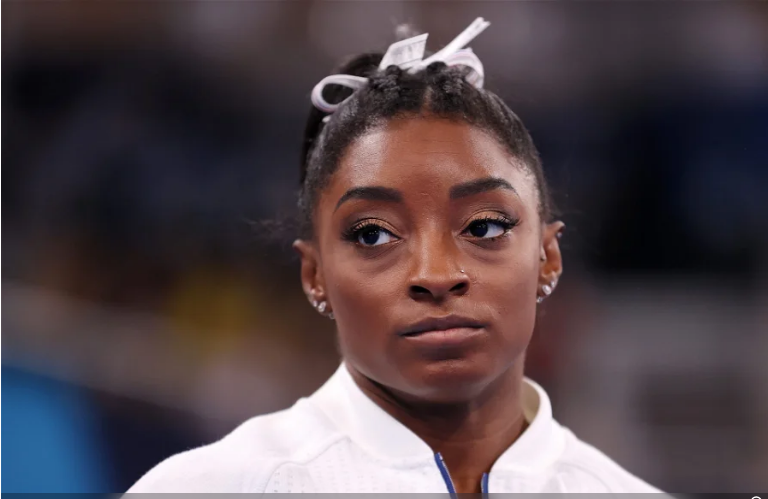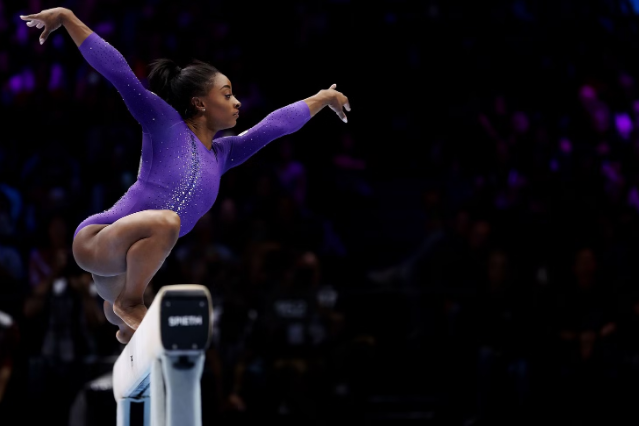Last week, 10 years to the day after a braces-bedecked Simone Biles claimed her first world title at Belgium’s Sportpaleis Antwerpen, the grown-up Mrs. Owens returned to that very arena. After scarcely a year back in the gym and in only her third competition since the Tokyo Olympics, Biles unequivocally dominated the 2023 World Championships. She left the arena on Sunday with her 26th through 30th world medals around her neck, making her the most decorated gymnast of all time, and obliterating any notion that the undisputed greatest athlete to grace the sport is anywhere near done with it.
Biles’ glut of 2023 hardware began in the team competition, as she led an all-star cast to victory over historic silver and bronze medalists Brazil and France. Biles then won her sixth individual all-around title, after a performance whose only notable flaw was an uncharacteristic stumble during a dance pass on floor exercise. (With Brazil’s Rebeca Andrade and Biles’ teammate Shilese Jones rounding out silver and bronze, we were also blessed with our first-ever all-Black worlds podium.) And the victories didn’t stop there: On the last day of the grueling, weeklong competition, Biles also won both the balance beam and floor exercise event finals.
But it is Biles’ lone glint of silver at this worlds—on the vault, the fast, dangerous event that she often dominates by nearly a point, but also the apparatus that brought on that dangerous bout of vertigo in Tokyo—that may be her most significant medal this year. Mind you, this is not because she “lost.” (As if a silver medal is for slouches! It is not!) It’s because of the statement that silver, and the score that earned it, continues to make about Biles’ priorities as an athlete and a human being.

To see what I mean, we have to rewind a week to the competition’s opening qualification round. There, Biles attempted the stratospherically difficult vault she debuted domestically in 2021: a roundoff (or “Yurchenko-style”) entry onto the apparatus, with a second flip added in “post-flight.” This vault had informally been called the “Yurchenko double pike” (or YDP for short), until the second this happened:
Watch as Biles salutes the judges after being the first to successfully land, in international competition, a skill previously inconceivable in women’s gymnastics. That’s the moment the YDP, heretofore not an official part of the Women’s Code of Points, was admitted to the Code and named after its originator: the Biles II. (Because oh, yes, Biles already has a difficult vault to her name, from 2018. She also has three other eponymous skills on other apparatuses.)
For this effort in qualifying, Biles received the highest score of the competition thus far: a 15.266, out of a total possible value of 16.4, which combines the potential “Perfect 10” of execution (which nobody gets anymore) with the skill’s 6.4 difficulty value, or DV. Now here’s where it gets tricky: Biles’ execution score in qualifying was a 9.366, which in the post-Perfect-10 world is quite high—especially considering the massive step back she took on landing (signifying too much power, which we will revisit momentarily). Her total score would have been a currently unheard-of 15.766. However, Biles lost another half-point because her coach, Laurent Landi, stood on the mat as a spotter.

What? You might be wondering. Aren’t spotters there for safety? Wouldn’t this be like Taylor Swift’s boyfriend getting a penalty for wearing a helmet on the football field?
Elite gymnastics has a complicated relationship with the spotter. In only one event, uneven bars, are spotters allowed without penalty—and this is only the case because of a rule change spurred by a grisly fall American gymnast Jennifer Sey took back in 1985. On balance beam, vault, and floor exercise, athletes who use spotters are penalized, because they do not typically fly as high in the air, and the physics of the elements make a head or neck injury considerably less likely. In the other events, elite gymnastics still believes, the presence of a spotter is a sign that an athlete is “chucking,” or attempting a skill outside their reach.
Because chucking is unsafe and unwise, the International Gymnastics Federation penalizes it to the greatest extent it can in the Code of Points. For example, the Code’s progressive devaluation of the infamous Produnova “vault of death”—essentially the mirror image of the Biles II with a front handspring approach and two front flips in post-flight—has successfully discouraged gymnasts from attempting this oft-chucked skill. To further discourage gymnasts from attempting moves beyond their abilities, the Code of Points also penalizes spotters.

However, the controversy over what is now being dubbed the “Laurent deduction” is that Biles isn’t chucking the Biles II. Simone Biles does not chuck, thank you very much. So why the spotter?
As someone who has done her share of spotting as a gymnastics coach, I can tell you from my training that spotting is not miracle work, and it’s not intended to prevent all injury. It’s to minimize catastrophic injury—i.e., a gymnast breaking her neck and potentially becoming paralyzed or dead.
So this, presumably, is why Landi and Biles (and the troika of experienced coaches currently in charge of the national team) have elected to have him spotting: When Biles performs the Biles II, she flies so high that if it goes wrong, it could go catastrophically wrong, much quicker than a single-flipping vault can. I hope I never have to see it proven, but clearly Biles and Landi believe that if her hand slipped on the table—which can happen to even the most expert gymnasts—he could save her life up there. If her coach’s presence on the podium makes Biles feel safe enough to grace the world with this vault, then so be it—even if there is a penalty to pay.
And pay she did. On Saturday, in the women’s vault event final, Biles once again threw the Biles II—but this time, unlike in qualification, her power was too much for her feet to catch up with, and she over-rotated and finished the skill on her back with her outstretched arms bracing her neck (a master class in fall safety, by the way). Thus she suffered the standard one-point deduction for falling—plus the half-point Laurent deduction, along with any small faults in execution incurred midair.
